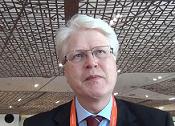Advertisment
ESMO WCGC 2013 Report – What is the most active first line treatment for patients with mCRC?

A review of the presentation by Volker Heinemann (pictured). The decision on first line treatment in mCRC matters because the number of patients benefitting from therapy diminishes with subsequent lines. The efficacy of treatment depends on the agents used and is critical to the overall survival (OS) of patients. First line therapy also impacts on the continuum of care; provides the highest survival rates; has the potential to allow resection and cure; and allows for the highest number of patients to receive treatment.
Dr Heinemann then presented data on a number of trials that showed varying levels of OS. Trial data comparing agents is starting to evolve. Data from trials such as PEAK, CALGB 80405 and FIRE-3 was shown, to emphasise head to head studies. Dr Heinemann who was an investigator on FIRE-3 presented some conclusions from the study:
- FIRE-3 is the first head to head comparison of FOLFIRI plus cetuximab versus FOLFIRI plus bevacizumab in KRAS wild type mCRC patients.
- The primary end point was not met. ORR favoured FOLFORI plus cetuximab but did not reach the level of significance within the ITT population
- First line treatment with FOLFORI plus cetuximab resulted in a clinically meaningful difference in median OS of 3.7 months (HR 0.77) when compared with FOLFIRI plus bevacizumab.
- Toxicity profiles were as expected and manageable for both combinations.
Click HERE for Slide ‘FIRE-3: OS (ITT)
Reproduced from presentation by D.Modest at WCGIC 2013.
Click HERE for Slide ‘FIRE-3: Exploratory subgroup analysis for OS (ITT)
Reproduced from presentation by D.Modest at WCGIC 2013.
Dr Heineman also presented the outline of the CALGB 80405study, another head to head trial comparing cetuximab plus chemotherapy and bevacizumab plus chemotherapy in first line mCRC. The primary end point is overall survival. The initial quality of life (QoL) and safety data was presented at ASCO 2013 and the efficacy data is expected in 2014.
Dr Heinemann then went on to discuss early objective tumour response (EOTR) and presented data from the ARCAD database that showed median OS was significantly longer in patients with an EOTR at 6,8 and 12 weeks compared to those without.
Early tumour shrinkage (ETS) and Deepness of response (DpR) were also discussed as potential predictors of survival. In both the CRYSTAL and OPUS trials ETS under treatment with cetuximab correlated with prolonged overall survival. In both these trials there was also an increase in DpR in the cetuximab plus chemotherapy arms. The data from CRYSTAL indicates that DpR has a greater impact on overall survival than on PFS.
In a subsequent presentation by Michel Ducreux from the Institut Gustave Roussy, France, first line treatments strategies were further explored. He showed that optimal first line therapy is based on current clinical evidence. The strategy should include a maintenance period or a chemotherapy free interval if appropriate. While ongoing treatment sequences will depend on first line response, quality of life and toxicities. Ongoing trials are looking at mechanisms of resistance, continuation of cetuximab post first line progression and response to re-challenge with anti-EFGR agents.





